“Early Firefighting In Sioux Falls”

(Note: any text in italics has been taken from the official SDSHS records.)
Subject
Sort of a place. The marker is right next to the Central Fire Station, which is on the location of the first fire tower in the city (according to the text of the marker). However, the marker is technically discussing early fire control efforts in the city, not so much a specific place.
Marker Text
A frontier town such as Sioux Falls, Dakota Territory, built almost entirely of wood and surrounded by highly flammable prairie grass could be swiftly consumed by uncontrolled fire. Without protection, farms and towns were vulnerable to prairie fires which might ignite very quickly and then burn fiercely for miles, subject to the whim and velocity of the wind. Many territorial newspaper editors were prompted to plead for an organized defense against this merciless element of nature.
In the 1870’s Sioux Falls was threatened with several fires, causing considerable community uneasiness. A volunteer bucket brigade, equipped with leather buckets, was formed in 1877 to ease this anxiety. A raging fire, starting north of Sioux Falls in 1879, took the life of Mrs. John Fortune, a farm woman caught in its path. The fire then swept down ‘Brewery Hill’ (North Main Ave.) threatening downtown Sioux Falls. Only the valiant effort of townspeople kept damage at a minimum.
In 1880, a group of volunteer firefighters organized the Cascade Hook and Ladder Company. Four years later a 2,600 lb. fire bell was purchased by the City Council and mounted in a fire tower (NE corner of 9th St. and Dakota Ave.), but within the year, a lightning bolt split the fire tower from top to bottom. By 1889, the volunteer fire department included a hook and ladder company, a two horse combination hose wagon, several hose companies and a chemical company.
The volunteer firemen were the pride of the city and received praise and honors for their skills and efficiency. Even so, the volunteers were not able to quell the disastrous fire which destroyed the landmark Cataract Hotel, the social center of the city, on June 30, 1900 (NW corner of 9th St. and Phillips Ave.). The citizens of Sioux Falls were shocked into the realization that their growing city needed highly trained, full-time paid firefighters. In response, a month later the City Council created an eight man salaried fire department, augmented by 15 ‘minute men’ unpaid volunteers.
This firefighting facility, the Central Fire Station, when built in 1912, was ‘the only building in South Dakota to be used exclusively for fire purposes’. The old 1885 fire alarm bell was installed in an 80 ft. bell tower. The tower was also used for the hanging and drying of fire hoses. The station had 11 horse stalls in the back with a hay loft on the second floor. When the fire bell sounded, the horses were trained to quickly trot to their places in front of the fire wagons where suspended harnesses were dropped on their backs and snapped into place. The horses were retired and replaced by motorized fire trucks in 1917. An era had ended.
Dedication Note
Erected in 1994 by the Minnehaha County and South Dakota State Historical Societies and Sioux Falls Area and Mary Chilton DAR Foundations and Sioux Falls Firefighters Assn., Local 814.
Location
Minnehaha County, Central Fire Station, Sioux Falls 100 Minnesota Ave. (2006)
On the corner of 9th and Minnesota, in Sioux Falls. Across from Graham Goodyear.
Is there anything to see?
Yes. The marker is right next to the Central Fire Station, and discusses some of its history.
Marker Images
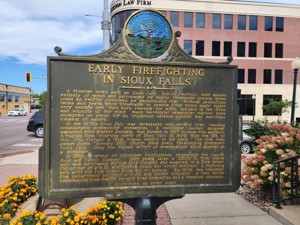

Other Images
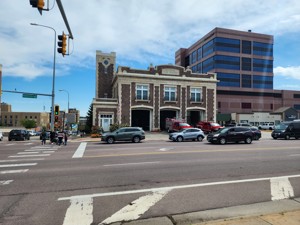
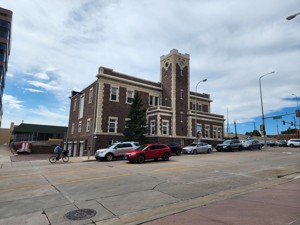
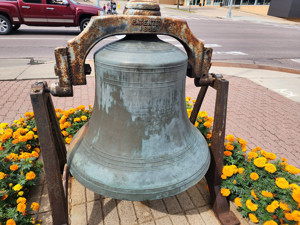
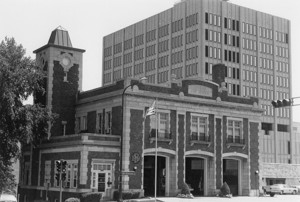

Links to Additional Information
The fire station has its own Wikipedia page, albeit a very short one.
Here’s the record for the fire station on the National Register of Historic Places. You need to scroll through the Nomination Form (its embedded as a PDF). The information is pretty dry and straightforward:
Central Fire Station, constructed in 1913, is important because of its relationship with the urban development of Sioux Falls, and therefore in the areas of architecture and government. It is a good example of fire station construction in the early decades of the 20th century designed for horse drawn equipment. The station house is constructed of Sioux Falls quartzite, quarried locally and used for public buildings throughout South Dakota.
Notably, the document is a scan of an actual physical copy. It’s signed May 27, 1980, and includes some pictures of the building, which I extracted and included above. Page five of the document is apparently where experts could provide their notes and opinions on the application. Under “Architectural Historian,” this is handwritten:
1st city fire station specifically constructed and possibly one of the earliest in the state. Utilizing classical motifs, the former horse and wagon station is of Sioux Falls quartzite. Accept [name illegible] 5.6.80
There’s also a page at the Society of Architectural Historians:
One of the oldest working fire stations west of the Mississippi River, and among the oldest extant buildings in downtown Sioux Falls, the Central Fire Station was designed by local architect Joseph Schwarz to accommodate horse-drawn fire equipment. After a massive fire destroyed the four-story Cataract Hotel (1884, Wallace Dow; 1889 addition) in 1900, Sioux Falls established its city fire department; prior to that, the city’s firefighters were volunteers.
NebraskaHistory.org has this to say about Schwarz:
Joseph Schwarz was born on February 24, 1858 in New York City. His family moved to La Crosse, Wisconsin in 1861. Joseph was trained in cabinet and furniture making, and later worked for a contracting firm, doing construction work. In 1887, he moved to Sioux Falls, where he lived and practiced architecture for the rest of his life. He was married to Eva (Capellen) Schwarz, with whom he had four children.[3] He was the architect for a large number of churches and public buildings in South Dakota, and was credited with designing several churches across Nebraska. He died on December 26, 1927.
Schwarz also designed other buildings in downtown Sioux Falls: the Carnegie Public Library, the Carpenter Hotel, and the First Congregational Church.
Every day, between 7,000 and 10,000 unique visitors come to this website. I don't keep analytics, so I have no idea why you're here. Maybe get in touch with me and tell me why you visited today?